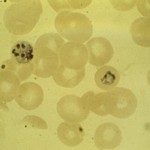Link to Pubmed [PMID] – 23204525
J. Biol. Chem. 2013 Jan;288(3):1590-602
Calcium-dependent protein kinases (CDPKs) play important roles in the life cycle of Plasmodium falciparum and other apicomplexan parasites. CDPKs commonly have an N-terminal kinase domain (KD) and a C-terminal calmodulin-like domain (CamLD) with calcium-binding EF hands. The KD and CamLD are separated by a junction domain (JD). Previous studies on Plasmodium and Toxoplasma CDPKs suggest a role for the JD and CamLD in the regulation of kinase activity. Here, we provide direct evidence for the binding of the CamLD with the P3 region (Leu(356) to Thr(370)) of the JD in the presence of calcium (Ca(2+)). Moreover, site-directed mutagenesis of conserved hydrophobic residues in the JD (F363A/I364A, L356A, and F350A) abrogates functional activity of PfCDPK1, demonstrating the importance of these residues in PfCDPK1 function. Modeling studies suggest that these residues play a role in interaction of the CamLD with the JD. The P3 peptide, which specifically inhibits the functional activity of PfCDPK1, blocks microneme discharge and erythrocyte invasion by P. falciparum merozoites. Purfalcamine, a previously identified specific inhibitor of PfCDPK1, also inhibits microneme discharge and erythrocyte invasion, confirming a role for PfCDPK1 in this process. These studies validate PfCDPK1 as a target for drug development and demonstrate that interfering with its mechanistic regulation may provide a novel approach to design-specific PfCDPK1 inhibitors that limit blood stage parasite growth and clear malaria parasite infections.
